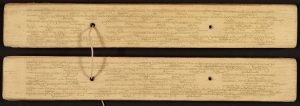The Rare Book Collection at UNC is proud of its global collections. Recently, we discovered a rare Sri Lankan imprint in our main library, Davis, and have arranged for its transfer to the RBC. The book, The Singhalese Translation of the New Testament (1820), is one of the earliest British books printed in the Sinhala language and a wonderful complement to the RBC’s collection of Sinhala olas, or palm leaf manuscripts.

Printing was introduced to Sri Lanka by the Dutch in 1734. The first book printed in Sri Lanka was published in 1737 using the first set of movable Sinhala type, which had been designed and cast by a local Dutch armorer. The Dutch printed a scant 22 books in Sinhala before ceding Ceylon (as it was then known) to the British in 1796. Although the British government took over the Dutch printing house and the Sinhala type founts, it was the religious societies—first the Columbo Auxiliary Bible Society (1812) followed by the Wesley Mission Society (1815)—that continued to print in the Sinhala language.
The Singhalese Translation of the New Testament is a major revision of an earlier, error-riddled edition published by the Colombo Auxiliary Bible Society in 1817. Much energy and money was devoted to the second edition, and a smaller, more compact Sinhala type font was specially commissioned for the octavo edition you see here. This book was intended to be widely distributed and easily carried. Printed at the Wesley Mission Press by a trained printer, this edition found praise among contemporaries for its typographical cleanness and elegance, as indeed it was by colonial standards.

By comparing an ola manuscript with the typography of The Singhalese translation, it is possible to study the relationship between Sinhala manuscript and print cultures. Scholars have argued that the rounded curves of the Sinhala script originated from the material constraints of writing on variegated palm leaves with a reed. Recently, Sri Lankan scholar and typography designer, Sumanthri Samarawickrama Jayaweera, has argued against such a reductive conclusion. You can listen to her engaging interview about the history of Sinhala printing and typography here. Jayaweera suggests that it was the introduction of colonial printing that ultimately changed how the Sinhala script was written—a process that might be traced in the RBC’s “new” copy of The Singhalese translation of the New Testament.
UNC’s ola collection, a gift of Dr. W.P. Jacocks, is not currently recorded in the online catalog but is described in H.I. Poleman’s Census of Indic Manuscripts in the United States and Canada (1967).
